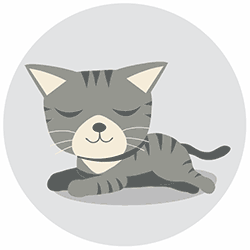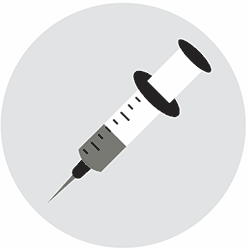AT THESE INITIAL VISITS, WITH YOUR INPUT, WE WILL DEVELOP A HEALTHCARE PLAN for your new pet.
A thorough physical exam will get them started out on the right paw. Risk factors will be discussed to be sure that your pets are appropriately vaccinated based on their individual needs.
Vaccinations
Puppies
To ensure puppy wellness, we should see your new pup every four weeks until 16 weeks of age. Routine exams allow your vet to ensure your puppy a great start to life by administering timely vaccines, checking for inherited defects and deworming.
Puppy Physicals:
Our doctors like to see all of our puppies every four weeks until 16 weeks of age. Routine puppy wellness exams allow early detection of potential health care issues. The exams will reassure you that you are on the right track to optimal health. Is your puppy the right weight? Are they growing normally? Keeping track of these things can help ensure a long, healthy life.
Or maybe there are more serious underlying issues to be aware of. Early diagnosis usually gives us a better outcome. Do they have a heart murmur? Is there a problem with their muscles or bones? Yearly exams are an integral part of your pet’s health care as they grow. As your pet ages towards their senior years we may even suggest exams every six months.
Kittens
Kittens should be seen by a doctor once a month starting at 8 weeks and continuing until they reach 16 weeks of age. Vaccinations, deworming and checking for inherited diseases are part of the preventative process to ensure your kitten is off to a healthy start!
Kitten Physicals:
Our doctors like to see all kittens every 4 weeks to make sure they are growing and developing appropriately. These frequent exams are important because they allow the doctors to detect different health issues from the basic like delayed growth or parasites to more serious problems like congenital defects. Early diagnosis of any condition can result in a better outcome. As we see your kitten back for further exams they will also receive their kitten series of vaccines and deworming medications which will help prevent them from getting sick from a preventable disease or a treatable parasite. Check out the links below for more information about your growing kitten.
Spay/Neuter Your Pet
Depending on the breed and age of your pet, your veterinarian will suggest a plan on when it is most beneficial to fix them. We will commonly discuss this during their final puppy/kitten exam, but if you have any questions or concerns before then, we are more than happy to answer!
Puppy Proof Your Home
Bringing home a new puppy can be a lot like bringing home a baby. Puppies are naturally inquisitive and can get themselves in trouble!
Here are some tips on how you can puppy proof your home and make it a safe place for your new arrival.
That’s Shocking: Young animals love to chew when they’re teething. Keep electrical wires out of reach, or use a repellent spray.
They’d Die for Some Chocolate: Chocolate can be dangerous. It contains theobromine, a powerful stimulant that is toxic to pets. Sweets, cakes and cookies can also upset a young animal’s G.I. tract and lead to diarrhea and vomiting, which can be serious.
Treats Can Be Threats: Never give turkey, chicken or rib bones as a treat. They can splinter and cause serious injury.
Common Household Killers: Cleaning agents, bleach, ammonia, disinfectants, drain cleaner, oven cleaner, paint, gasoline and rat poison. Keep them all locked up.
Check the Antifreeze: Pets are attracted to the odor and sweet taste of antifreeze. Store it high and tightly sealed, wiping up any spills on the garage floor. Window washing solution also contains antifreeze. And remember, engine warmth promotes cat naps, so honk your horn to wake pets under the hood.
Killer House Plants: Poisonous plants include lilies, philodendron, dieffenbachia, elephant ear, eucalyptus, azalea, ivy, amaryllis, pyracantha, oleander, boxwood, Jerusalem Cherry and plant bulbs. You can also check out your plants on the ASPCA’s Toxic and Non-Toxic Plants page.
Keep Off the Grass: If you treat your lawn with chemicals, keep pets away. Read and follow label directions carefully.
It Fit Yesterday: Puppies and kittens grow rapidly. Collars and harnesses can be rapidly outgrown, leading to serious wounds.
Take Care of Personal Care Items and Medications: Cosmetics, shampoos, skin creams, hair “perm” solutions, depilatories, suntan lotions, sleeping pills, antihistamines, aspirin and acetaminophen can all be lethal to pets.
It’s Not a Toy: Don’t leave plastic bags out. Inquisitive young animals, especially kittens, can suffocate.
The Heat is On: Watch out for hot irons, coffee pots and space heaters. Kittens and puppies will suddenly be able to jump to new heights.
A Dip Tip: Keep covers on hot tubs and swimming pools. Kittens and even young puppies can fall in and not be able to get out.
‘Tis the Season: Keep holly, mistletoe and especially Christmas tree tinsel out of reach.
Cozy Up: Always use a fireplace screen.
Do You Eat with That Mouth? Rule of Thumb: If any or all of something will fit in a mouth, it’s dangerous. Watch out for cigarette butts, rubber bands, balloons, sewing needles, thread, string, ribbons and, yes, even pantyhose. Because what goes in must come out, often via surgery.
These household safety tips were provided compliments of Pfizer Animal Health 1995
House Training Your Puppy
Housebreaking can be frustrating for every owner. The trick is to start early.
The more accidents in the house the longer it is going to take to train your new pup. Here are some tips that the staff has put together.
Provide your puppy with an airline crate or similar enclosure:
- This replicates the natural “den” all wild canines are born in.
- Think of your puppy’s crate as its den.
- They feel safe in the den when sleeping or when the pack is away hunting.
- Their instincts tell them not to eliminate in the den.
- Your puppy should sleep in its den adjacent to your bed.
- Your puppy should sleep in its den when you are away during the day.
- Never use the crate as punishment.
Be consistent with trips outside.
- Always go out the same door.
- Each time you take your puppy out, lead it to the same place that you want it to eliminate.
- Stand with the puppy and give it a command (“Hurry up” or “Go pee”).
- Praise the puppy when it eliminates and then take it immediately back inside.
Make a chart of meals and eliminations.
- It is usually safe to allow the puppy to explore for 1-2 hours after elimination.
When you are at home and the puppy is outside of its den, it must be confined in some way. Some ideas include:
- On a leash tied to the owner.
- In an area or small room blocked with a gate or door.
- In a playpen.
- If you cannot watch it closely, the puppy should be put back in its den.
- Remember that dogs are social animals and that effort should be made to minimize confinement from the family.
A Typical Day:
- 6 am: The puppy is awake and in the crate. Let it outside immediately.
- Give breakfast for about 15 minutes. Watch for signs that the puppy has to eliminate then take it outside.
- When you leave for work or school, put the puppy in its crate.
- Noon: Let the puppy outside to eliminate.
- When you go back to school or work, return the puppy to the crate.
- 4-6 pm: Take the puppy out to eliminate.
- Give dinner for about 15 minutes. Watch for signs that it has to eliminate then take it outside.
- Evening is free time for people. It is also the time when the most accidents occur. Keep the puppy with you or confined.
Signs of needing to eliminate include:
- Sniffing, circling and whining.
- Watch for signs after eating, napping and playing.
- Take your puppy out immediately when you see these signs.
If you catch your puppy in the act of “eliminating” in an inappropriate place:
- A quick “No” and bringing the puppy outside immediately is appropriate.
- NEVER punish the puppy after it has finished eliminating.
- Never rub its nose in its urine or stool.
- The puppy does not know that it is doing something wrong before or even minutes after it has eliminated inappropriately.
How long can you expect your puppy to go without eliminating?
- 6 to 8 weeks – 4 hours
- 12 weeks – 4 to 6 hours
- 16 weeks – 8 hours
Training Your Puppy
We base our training on the theory that “nothing in life is free”. This is a simple, day-to-day training process that doesn’t take any extra time and anyone can do.
Much of a puppy’s behavior is geared towards getting your attention. They demand attention and we give it to them. This makes it pretty easy for them to assume that they are the boss. You might think, “But I don’t pet him, I tell him no and push him off me!” You can reinforce a puppy’s behavior (good or bad) by paying attention to it. There are three basic ways to give a puppy attention:
Eye contact: Looking at your dog
Voice: Talking to your dog, saying “good dog”, or even “NO!” is paying attention to them
Touch: Petting your dog, or even pushing them off you, grabbing them to take something away
- This technique will establish your position of authority, takes no extra time and anyone can do it!
- Simply require your puppy to “sit” or “down” prior to feeding, petting, giving attention, etc.
- If your puppy doesn’t follow your command, then ignore them for 5 minutes and try again.
You can call and let the staff know what you are having a problem with and we can help you address the behavior. For more destructive or dangerous behaviors and problems like separation anxiety and barking, we can arrange a 30 to 60 minute behavior consultation with one of our veterinarians.
Puppy, basic & advanced training classes can help you address behavior problems such as housebreaking, walking on a leash and more. Puppies must be at least 8 weeks old and show proof of vaccinations. The training process is based on positive reinforcement.
Puppy Classes Are Available at These Locations:
Green Acres Kennel 1653 Union St Bangor, ME 04401. (207) 945-6841
Country Kennels 1708 Stillwater Ave Bangor, ME 04401. (207) 945-9221
At Green Acres, Puppy Head Start is available as a one-on-one with a trainer for a personalized start to training before regular classes begin. Please call either facility for more information and class times.
Puppy Socialization
A puppy’s critical window of socialization is from 6 weeks to 6 months
Every effort should be made throughout this very important period to allow the puppy to bond with the family. During this time, you should also expose your puppy to every situation or procedure that it could potentially encounter in his or her lifetime.
Encourage your new puppy to get used to the following: riding in the car, kids, bikes, delivery men, vacuum cleaners, being touched while eating, touching its feet, clipping its nails, brushing its fur, looking in its mouth, eyes and ears, getting picked up and being rolled on its back, as well as any other situation that it may face.
The more places that you take your puppy, the more it will be exposed to new and different experiences so that it will learn not to be as afraid as it would have been had it never been exposed to these new things.
We do not recommend gating your puppy in the kitchen away from the rest of the family. If you are afraid that your puppy will have an accident in the house, the best thing that you can do is to put them on a leash and attach the other end to you. The puppy will never be out of sight, and you can watch for signs of it having to eliminate. The puppy will get to bond with you at the same time.
When you are not at home and cannot be with your puppy, a crate is a safe place for a puppy to be and to feel comfortable. This will prevent inappropriate elimination (most dogs will not eliminate where they have to sleep) and prevent mischievous chewing.
You should practice leaving the puppy at home alone. Start with short intervals of time, gradually building up the length of time that it is left in the crate. This will help prevent separation anxiety.
Jumping & Biting
Lots of puppies have a tendency to jump, nip and bite. In general it’s not because they are mean, but because they are treating you like a litter mate. Here are some helpful suggestions to stop this type of behavior.
Jumping Up
Why: Puppies jump on you to get close to your face to greet you.
To stop: The best way to stop your puppy from jumping is to turn away and ignore it as soon as it jumps up. By ignoring it, the behavior becomes self-defeating. In a short period of time, it will learn that it does not get any attention when it jumps.
- All verbal cues such as telling them “Down” or “Off”, kneeing them or grabbing their front legs are all forms of attention and will encourage puppies to jump on their owners.
- Even small children can be taught to turn their backs so the puppy does not jump on them. Children should go to the corner with their hands in front of them so that the puppy cannot get at them.
- The best thing for young children to do when a puppy is too rough is to stand still so the pup loses interest.
- Ignore rambunctious behavior when you or company comes through the door. As soon as it settles down, focus your attention on it. This rewards good, calm behavior.
- Ultimately the dog should sit for you when you come through the door.
Biting
Why: Puppies bite at our hands, feet and clothing in an attempt to engage us in play.
To stop: The best way to discourage the puppy from biting is a technique called bite inhibition.
- When the puppy bites too hard, you should yelp, pull your hand away and ignore it for a few minutes. Your puppy will quickly learn that if it bites too hard, the play will end.
- The purpose of its biting was to initiate play and therefore becomes self-defeating when you ignore it.
- Although roughhousing does not encourage biting, avoid any interaction that causes it.
The Purrfect Home for Kittens
Bringing home a new kitten isn’t usually quite as simple as just bringing them home and setting them loose. You should consider the safety of their new environment as well as the things you will need to create a safe and happy home for kittens.
Things you will need:
Food & Water
- Ideally, one food/water station per cat. Feed a quality kitten food until 8-10 months of age at which time you can gradually change to an adult version.
- Food and water should be separate not only from each other but from litter boxes (ideally all in separate rooms).
- Ideally offer both wet and dry foods. Wet food is actually the best/more natural choice for cats as it is mostly protein and little carbohydrates (whereas dry is the exact opposite). There may come a time in your cat’s life when wet food would be the only thing we would want them to eat; the more familiar they are with this the better.
Litter Box
- Ideally 1 box per cat plus 1 (if you have 2 cats, then should have 3 litter boxes, 3 cats, 4 boxes, etc.) placed in different, quiet areas of the home.
- Size of the box should be 1 ½ times the length of the adult cat (excluding the tail).
- Most cats prefer fine grained clumping litter.
- Generally 3” of litter is sufficient.
- Scoop daily and totally change/clean with mild cleaner (like ivory soap) weekly.
Environment
- Scratching posts: Scratching is a natural cat behavior. Cats scratch not only to keep their claws trim/sharp but also as a means of communication. Experiment with location and material. Some cats prefer sisal rope, others cardboard or carpet. Some prefer vertically placed areas while others may like horizontal surfaces.
- Toys: Hunting is a natural cat behavior. Since indoor cats do not have to hunt for their food they need other outlets to satisfy this natural behavior. Try different types of toys to elicit various instincts:
- Wand toys (things that dangle with feathers or strings)
- Light toys (lasers, and even some computer games)
- Things that make sound (things that squeak and jitter)
- Small furry toys (like mice)
- Simple household things like: crumpled up balls of paper, the plastic ring off of milk jugs, the center roll from toilet paper or paper towels
- Kitten Proofing: Kittens get into everything! Make sure that any elastics, string/yarn and small items such as earplugs are kept out of reach so your kitten does not swallow them and get into trouble! Check out this ASPCA link to see a list of toxic plants.
House Training Your Kitten
While most cats can be trained to use a litter box, it’s important that you help your kitten get off to a good start. If possible, you should obtain a kitten that already has been litter box trained in its previous home. It will adapt to a new environment more quickly than a kitten that has not been trained.
Taking the Hassle out of House Training Your Kitten
Wayne L. Hunthausen, DVM, and Gary M. Landsberg, DVM, Dipl. ACVB
While most cats can be trained to use a litter box, it’s important that you help your kitten get off to a good start. If possible, you should obtain a kitten that already has been litter box trained in its previous home. It will adapt to a new environment more quickly than a kitten that has not been trained.
The Right Equipment
When you get a new kitten, find out what type of litter is used in its previous home. Use the same type of litter at first, then gradually introduce it to a new brand if necessary. Often a plastic box is the most practical and easy to clean. The sides should be low enough that your kitten can easily climb in and out. Place the box in a relatively quiet area of your home with minimal traffic, where your kitten can have some privacy. Be sure the box is easily accessible, perhaps near to your kitten’s sleeping area.
Some kittens dislike scented litter, so it is usually best to start with an unscented clay or clumping litter. If you already have cats at home, provide an additional box for each new cat. Most kittens will automatically use kitty litter in preference to other surfaces, except perhaps the soil of a potted plant. To prevent mishaps, keep plants out of your kitten’s reach or cover the soil with pine cones or decorative rock.
To ensure that your kitten uses its litter box every time, keep it within eyesight at all times. If it stops playing and begins sniffing around, gently carry it to the litter box. Praise any sniffing or scratching and give it loads of praise or a small food treat for eliminating. Whenever you are unable to watch your kitten, restrict it to a cat-proofed room with its litter box. Continue this for at least the first two weeks, until your kitten is using its box regularly.
Using a covered litter box can help control the odor in your home and can be helpful for kittens with poor aim. If your cat is reluctant to use a covered box, condition it to this setup by placing a large cardboard box over its litter box. Gradually decrease the size of the cardboard until it approximates the commercial box. Then make the switch.
It’s a Dirty Job but You’ve Got to Do It
You must keep the box clean so that your kitten will return to use it. To start out, it is better to err on the side of being too fastidious about the cleaning. Scoop the box at least once daily and more often if you have the time. Completely clean the entire box once a week, unless you are using a clumping litter (which might only need a complete cleaning every two to four weeks). To clean the box, empty out the contents, use a mild soap and hot water, and rinse well to remove all the soap odor.
Once you have found a brand of litter, type of box, and location your kitten likes, avoid making sudden changes. If you want to change the litter, place the box with the new litter in a new location, but do not take away the old litter until your kitten is using the new brand. Or try mixing the new and old brands for a few weeks.
Since it is important that your kitten feels comfortable where it eliminates, try to prevent anything unpleasant from happening when it is near its litter box. Don’t give your cat medicine or scold it when it’s near the box. Locate the box in an area free of startling noises, such as a washing machine, radiator, or furnace. If you need to keep your kitten away from children or dogs, use a baby gate or a kitty door to a quiet room.
When Mistakes Occur
If your kitten eliminates outside its box, it won’t take long for it to develop a habit of using this undesirable area. So it is essential that you identify and correct the cause right away.
Causes for House Soiling:
- Brand of litter was changed
- Litter has scented additives or the odor of cleansers/deodorants
- Litter box is not cleaned frequently enough
- Litter box was moved to a noisy area
- Kitten was frightened in or near the box
- Kitten has medical problems
- Changes in a previously stable social structure can cause behavioral problems including eliminating outside the litter box
If the habit persists make certain that the soiled area has been thoroughly cleaned and treated with a commercial odor neutralizer. Many cats will not soil an area where their food or water is placed. To decrease the appeal of the soiled area, place a sheet of plastic carpet runner (nubs up), two-sided sticky tape, an aversive odor (perfume, deodorized soap), or a motion detector alarm in the area.
Never punish your kitten for making a mess outside its litter box. Punishment usually makes things worse or creates other problems such as fear of the owner, especially if you swat your kitten or rub its nose in the mess.
If your kitten continues to eliminate out of the litter box, take it to your veterinarian. A physical exam and lab tests can make sure there are no existing medical problems. For example, bladder disease, diarrhea, and constipation can irritate your kitten when it eliminates and cause it to avoid the box. Please schedule an appointment.
Spraying
As kittens mature, they may begin to spray. Spraying is a form of territorial marking—cats typically will urinate on vertical surfaces such as walls and furniture. Although neutering eliminates most spraying, some neutered cats do spray. If the problem persists after neutering, seek advice from your veterinarian.
Kittens are creatures of habits. Once you find a litter and box location that the cat likes, stick with it.
Inappropriate Elimination
Although most kittens are litter trained at 8 weeks of age, some are up to 6 months before they are reliably using their box. If you adhere to the following guidelines you will give yourself the best chance of success when “training” your kitten to go in the right spot.
- Most cats prefer fine grained clumping litter at 3” depth
- Scoop box daily and completely change/clean box weekly (with an unscented detergent like Ivory or Dawn).
- Ideally use a relatively shallow/uncovered box that is 1 ½ times the length of an adult cat (excluding tail)
- Make sure the box is in a quiet/private area of the home
- Number of boxes in the home should be one more than the number of cats (i.e., if 3 cats, 4 boxes). Make sure they are available on each level of the home and not all gathered in one area
Kitten Behavior
Kittens are curious about their environment. They sometimes can get themselves into trouble, or mischief. Here are some suggestions regarding kitten behavior and how to protect both your kitten and your house!
Is Your Kitten Scratching the Furniture?
All cats will scratch objects in their environment. This is normal behavior to remove the outer cuticle and to communicate with each other through visual and scent marking.
Make sure there are a variety of acceptable surfaces in the home that are okay for your kitten to exercise this normal behavior. If you do not, you can be sure your kitten will find an area that may not be acceptable to you. Bear in mind that cats have preferences; some like horizontal surfaces, and others vertical. Some like carpet where others like sissal rope or cardboard. Experiment with different textures and surfaces to determine your kitten’s preference.
If your cat has decided on an area/surface that is unacceptable (an expensive piece of furniture, for example) retraining is advised. To help break/prevent this habit you need to know why kittens or cats scratch.
Cats may scratch to mark their territory. They do this by:
- Visually marking the object (defacing the furniture)
- Leaving their scent from the glands in their paws
Now that we know why they scratch, we can use scratching posts and nail trims to modify their behavior. Scratching posts can be purchased or constructed at home. The covering material should be similar to the furniture the cat uses most and the scratching post should be placed immediately in front of the furniture they are scratching. You can sprinkle catnip on the post for an added incentive. After your kitten adjusts to the post, you can slowly move it to a discreet spot later.
Deterrents to Accelerate Scratching Post Training
- Cover furniture with a “scat mat” or two-sided tape on cardboard. The kitten won’t like the feeling on its paws.
- Place mouse traps UPSIDE DOWN (so they won’t catch the cat’s paws) and cover them with newspapers on/around furniture. Be very careful.
- Install a motion sensor to turn on the radio, which will scare the cat away when it scratches.
- Keep a hair dryer on the furniture attached to a long cord. When you hear the cat scratching, plug in the cord. The noise will deter the cat from scratching. It won’t associate you with the noise, so it won’t become afraid of you.
Nail trimming helps by keeping the nails dull and slowing their growth. The younger the kitten is, the easier it will be. Trimming 1-2 times a week is best. Feel free to ask a technician for help anytime.
Biting/Scratching
Kittens love to play, especially between the ages of 6-16 weeks. Most kittens, through play with their littermates, learn that biting and scratching hurts. If your kitten is showing signs of aggressive play, redirect its behavior to objects other than your hands and feet. Experiment with different types of toys (furry-‘mouse-like’ or feathers-‘bird-like’ or chasing a string on a stick or laser pointer). It’s also important to circulate toys as your cat will get bored. If you notice they are starting to ignore a toy put it away and try another (“absence makes the heart grow fonder”). You will be surprised how enthusiastic your cat/kitten will be when the forgotten/shunned toy is reintroduced at a later date.
You may have other cats, especially older ones, who won’t be thrilled with the new kitten’s robust play. You may want to consider adopting two kittens; more often than not the kittens will entertain each other and leave the older cat alone. If adopting two is not feasible, extended play sessions with your kitten on a daily basis will help.
The Feline Terrorist: Taming the Kitten with an Attitude
By Wayne L Hunthausen, DVM, and Gary M. Landsberg, DVM, Dipl. ACMB
Young cats and kittens can be quite serious when it comes to play. For felines, play prepares them to become great hunters and helps develop social skills with other cats. But this behavior is not fun when the pet treats us like big mice or when its playful pounces puncture our skin.
Although play bites are usually inhibited and swatting is often done with retracted claws, sharp teeth and nails can damage our clothing or inadvertently cause injury. The danger of serious injury increases when the behavior is directed toward the face, a family member with fragile skin, or toward someone with an immune deficiency disorder.
Play attack problems typically involve young cats that are alone during the day. The attacks escalate when they are reinforced by someone who thinks the behavior is cute and encourages it. Besides exploration and investigation, kitten play typically involves elements of predation such as stalking, chasing, attacking, catching and biting. Most kittens engage their peers in rough-and-tumble play. When another feline playmate is not available, a nearby family member becomes the next-best target. Although you may be an appealing target for play, you don’t have the fur, defenses, or mobility of another cat, which increases the likelihood of injuries.
Avoid training a kitty to be a terrorist. Teasing a small kitten with your fingers and toes may seem like fun, but this will quickly change as the pet grows older and the bites become harder. It you want to be more to your cat than a big toy, take an early stand. While some of these little guys can become quite bloodthirsty and relentless, their behavior can be controlled.
Controlling the Little Beast
Since play is a normal behavior, it is important that the cat has an acceptable outlet for it. Providing a feline playmate of the same age and temperament will usually draw the attack behavior away from you and toward the new buddy. Only consider this option if you are prepared to take on the extra care that a second pet warrants. If adding another pet to the home is out of the question, then you must shoulder the responsibility for providing the proper type of play and shaping your pet’s behavior.
Play interaction with the cat should involve tossing or dangling toys for it to chase and catch. This directs the attacks away from you. The more vigorous the interaction, the better. Keep your kitten so busy and worn out that it doesn’t even think about going after you. Check out your local pet store and stock up on all types of fun, tempting cat toys. Or provide inexpensive toys such as ping pong balls or unshelled walnuts for swatting. Adding catnip to the toy or stuffing or coating it with food can sometimes increase its appeal. A short fishing rod is great for casting small rubber or feather toys, and provides entertainment for you and your cat. Always maintain control at playtime. Play that is initiated by the cat should be ignored or interrupted; you should start all play.
To Swat or Not to Swat
Physical punishment, such as swatting the pet or thumping it on the nose to stop rough play, should be avoided. It may cause your cat to either fear you or encourage even rougher play. A blast of air from a compressed air can (obtained from a photography store), a squirt from a water gun, or an audible alarm are safe ways to discourage behavior. This approach is only likely to work when you can anticipate an attack and are prepared to interrupt your kitten as it begins its assault. This is not always an easy task. Attacks are most likely to occur when you’re making some interesting movement, such as dusting, making the bed, reading a newspaper, or walking down the stairs. Vigilance is a necessary ingredient for being consistent in teaching your kitten not to attack.
Up All Night
Nighttime attacks are more difficult to handle and, in most cases, the only simple solution is to keep the cat out of the bedroom when you sleep at night. Often, this behavior will decrease and finally stop as the pet grows older. If the attacks are not so bad, but the kitten has the annoying habit of waking you up by sucking on earlobes or elbows as you sleep, try applying a light coat of underarm deodorant to those areas to discourage it. Or keep a can of compressed air nearby to deter those surprise attacks.
Family Feuds
Problems with other cats in the home can occur when the play target is another cat that is weak, fearful, or old, and cannot tolerate the young cat’s playful behavior. The pets should be kept separate unless supervised. A water gun can discourage exuberant play, and appropriate toys can keep the rambunctious cat occupied. Sometimes, the cat bearing the brunt of play attacks can become so stressed that additional help may be needed. Medication may reduce its anxiety – discuss this option with your veterinarian.
Nail Trimming – An Ounce of Prevention
Since young kittens tend to use their paws a lot in play, it’s a good idea to keep those nails trimmed to prevent them from snagging sensitive skin. It’s easy to condition your cat to accept nail trimming, but you must have patience and pick the right time. The very worst time to attempt nail trimming is when the pet is alert and active. (It may seem this is always the case, but all kittens eventually nap.) Handle the paw very gently, use a sharp pair of trimmers, and quickly take off the tip of one nail. If the pet continues to snooze, take the tip off another nail or two. If your cat stirs, pet it gently and give it a small treat. Never force the pet to hold still for a nail trim, and always cease before the pet squirms. You can see a video on how to trim nails here.





